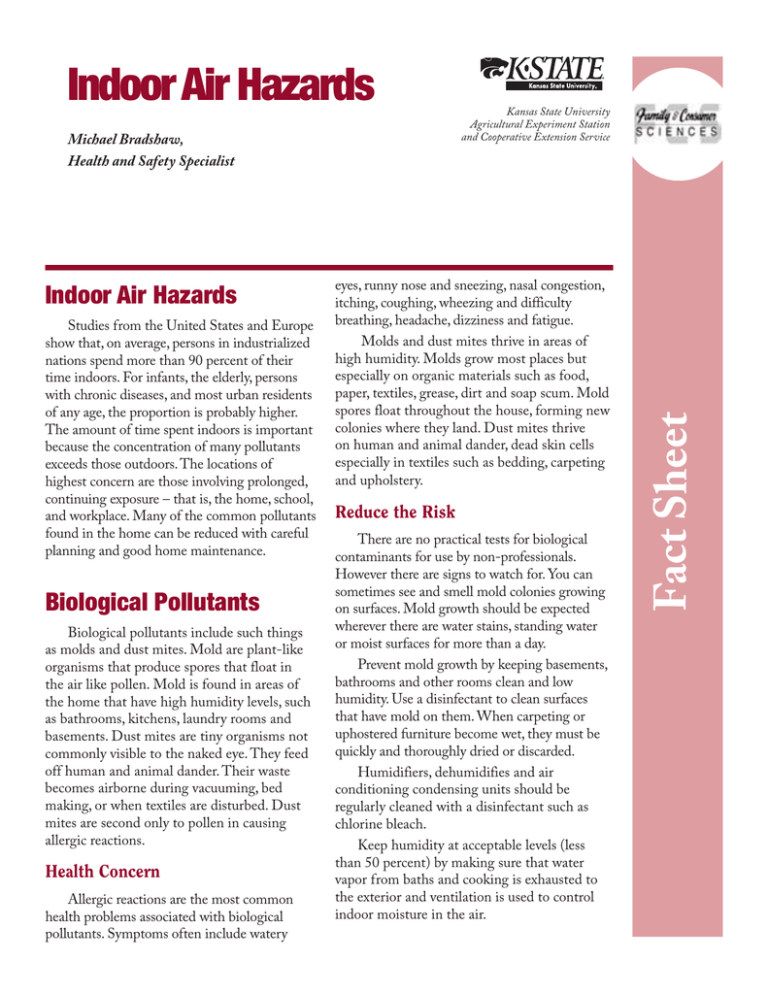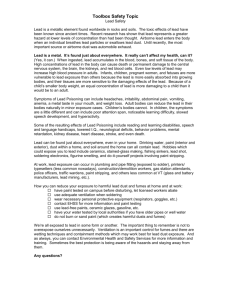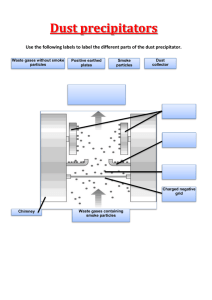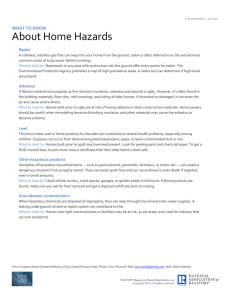
Michael Bradshaw,
Health and Safety Specialist
Indoor Air Hazards
Studies from the United States and Europe
show that, on average, persons in industrialized
nations spend more than 90 percent of their
time indoors. For infants, the elderly, persons
with chronic diseases, and most urban residents
of any age, the proportion is probably higher.
The amount of time spent indoors is important
because the concentration of many pollutants
exceeds those outdoors. The locations of
highest concern are those involving prolonged,
continuing exposure – that is, the home, school,
and workplace. Many of the common pollutants
found in the home can be reduced with careful
planning and good home maintenance.
Biological Pollutants
Biological pollutants include such things
as molds and dust mites. Mold are plant-like
organisms that produce spores that float in
the air like pollen. Mold is found in areas of
the home that have high humidity levels, such
as bathrooms, kitchens, laundry rooms and
basements. Dust mites are tiny organisms not
commonly visible to the naked eye. They feed
off human and animal dander. Their waste
becomes airborne during vacuuming, bed
making, or when textiles are disturbed. Dust
mites are second only to pollen in causing
allergic reactions.
Health Concern
Allergic reactions are the most common
health problems associated with biological
pollutants. Symptoms often include watery
Kansas State University
Agricultural Experiment Station
and Cooperative Extension Service
eyes, runny nose and sneezing, nasal congestion,
itching, coughing, wheezing and difficulty
breathing, headache, dizziness and fatigue.
Molds and dust mites thrive in areas of
high humidity. Molds grow most places but
especially on organic materials such as food,
paper, textiles, grease, dirt and soap scum. Mold
spores float throughout the house, forming new
colonies where they land. Dust mites thrive
on human and animal dander, dead skin cells
especially in textiles such as bedding, carpeting
and upholstery.
Reduce the Risk
There are no practical tests for biological
contaminants for use by non-professionals.
However there are signs to watch for. You can
sometimes see and smell mold colonies growing
on surfaces. Mold growth should be expected
wherever there are water stains, standing water
or moist surfaces for more than a day.
Prevent mold growth by keeping basements,
bathrooms and other rooms clean and low
humidity. Use a disinfectant to clean surfaces
that have mold on them. When carpeting or
uphostered furniture become wet, they must be
quickly and thoroughly dried or discarded.
Humidifiers, dehumidifies and air
conditioning condensing units should be
regularly cleaned with a disinfectant such as
chlorine bleach.
Keep humidity at acceptable levels (less
than 50 percent) by making sure that water
vapor from baths and cooking is exhausted to
the exterior and ventilation is used to control
indoor moisture in the air.
Fact Sheet
Indoor Air Hazards
People who are sensitive to dust mites may
need to replace carpeting in their homes with
hard-surfaced flooring and use area rugs that
can be removed and cleaned.
Vacuums with high-efficiency filters, water
filtration systems or central vacuum systems
can help reduce the airborne dust generated by
vacuuming.
Carbon Monoxide
Carbon monoxide is an odorless, colorless
gas that can be fatal when breathed. It is
produced when combustion equipment is not
working properly. Sources include unvented
fossil-fuel space heaters, unvented gas stoves
and ovens, blocked chimneys or flues, gas dryer
vented into the room, cars or other engines run
in garages, and cracked combustion chamber in
the furnace, and “backdrafting” from furnaces
and water heaters.
Health Concern
It’s sometimes difficult to determine if
a person is experiencing carbon monoxide
symptoms or if they are experiencing
symptoms of the flu, food poisoning, or
allergies. Low levels of carbon monoxide can
cause nausea, dizziness, weakness and muscle
aches. Higher doses can impair judgment,
cause paralysis or coma, and death.
Reduce the Risk
Carbon monoxide alarms alert you to
dangerous levels of carbon monoxide. It is
important to choose and place an alarm wisely
and maintain it to assure accurate sensing of
carbon monoxide. Experts recommend having
your combustion heating systems inspected
by a trained professional every year. Such
inspections should look for blocked openings
to flues and chimneys; cracked combustion
chamber, or disconnected flue pipe; signs of
soot around openings in your furnace or boiler;
rust or cracks in the heat exchanger; soot or
creosote build-up; and exhaust or gas odors.
Household Products
Volatile Organic Compounds (VOCs)
are found in many household products. They
are chemicals that easily evaporate to vapor or
gas at room temperature. They are found in
paints, solvents, air fresheners, hobby supplies,
automotive products, dry-cleaned clothing,
moth repellents, pesticides and some cleaners
and disinfectants aerosol sprays, adhesives,
manufactured wood products (pressed board), and
fabric additives used in carpeting and furniture.
Some common volatile organic compounds
(VOCs) listed on product labels are: petroleum
distillates, mineral spirits, chlorinated solvents,
carbon tetrachloride, methylene chloride,
trichloroethane, toluene and formaldehyde. Other
household product ingredients can also be a
hazard if they are used improperly.
Health Concern
The unsafe use of many common
household products can cause many
undesirable health effects. Short-term effects
include eye, nose and throat irritation, and
headaches. Long-term exposure can cause loss
of coordination; nausea; and damage to liver,
kidneys and the central nervous system. Some
organics can cause cancer in animals and are
suspected of causing cancer in humans.
Reduce the Risk
First, read the labels of products you
are considering buying. Note the product’s
ingredients and beware of all warnings of its
use.
Always use household products only for
their intended purpose and according to the
manufacturer’s instructions. And use them
sparingly.
When possible use the product outdoors, in
a separate building, or in a well-ventilated area.
Choose products that are packaged to
reduce the chance of spills, leaks and child
tampering.
Keep household products in their original
containers so that safety information and
directions for use are always with the product.
Lead Dust
Lead dust is a metallic element that is
widely dispersed in the environment. It was
used in oil-based paint until 1978, when it was
banned. An estimated 57 million U.S. homes
have at least some lead paint. Older homes are
at greater risk. Prior to 1950, paint contained
as much as 50 percent lead. Lead can be found
near major traffic corridors in soils that have
been contaminated from the long-term use of
leaded gas.
Paint in good condition poses little
risk. Paint that is peeling, chalking, or on
deteriorating surfaces is especially risky.
Sanding, scraping, and burning paint during
remodeling can expose family members to high
levels of lead. Lead has been used in many
products, including automotive batteries, brass,
solder, some plumbing pipe, and weights. Some
imported products such as toys, candy, jewelry
and pottery can also be exposure risks.
Health Concern
Young children (up to about six years
old) are especially at risk of ingesting lead
contaminated dust or paint chips. Small
amounts of lead dust, consumed regularly,
can cause delayed development, reading and
learning problems, lowered IQ, hyperactivity
and discipline problems. Larger doses can cause
high blood pressure, anemia, and kidney and
reproductive disorders in both children and
adults. Lead accumulates in the body and its
effects are irreversible. If you live in an older
home, your children may be at high risk.
Reduce the Risk
Testing:
All children up to age six should be tested
for lead in their blood. Ask your public health
department about lead testing programs for
children.
Do-it-yourself test kits are available at home
centers, paint stores and ceramic supply stores.
Their sensitivity is limited, though. Also, it may
be difficult to get accurate readings on surfaces
with multiple levels of paint. For more accurate
information, have a professional detection service
conduct a lead-based paint risk assessment.
Paint over surfaces before they peel, flake,
or chalk.
Pick up loose paint chips with masking
tape or duct tape.
Frequently damp mop to control dust if
you live in an older home that likely or possibly
has lead paint. (Vacuuming can disperse dust
particles back into the room.)
Frequent washing of your child’s hands and
toys will also reduce exposure.
It’s important not to sand or scrape leaded
paint, or do any other activities that generate
dust.
Eliminating lead dust hazards is complex
and should only be done by professionals.
Remediation measures include replacing
windows and moldings, removing paint and
covering surfaces with materials such as
wallboard. Children should be removed until
the site “clears” inspection.
Radon
Radon is an odorless radioactive gas
that results from the breakdown of uranium
from soil and rock beneath and around the
foundation, ground water wells, and some
building materials.
Radon can leak into your house through
the basement or crawl space – via adjacent or
exposed soil and rock – or through well water.
Some building materials such as natural stone
or rock can emit radon.
Health Concern
Exposure to radon can increase your
chances of getting lung cancer. Scientists are
more certain about radon risks than risks from
most other cancer causing substances. Radon
is the second leading cause of lung cancer
in the United States. Radon causes 15,00022,000 lung cancer deaths each year. Smoking
combined with radon exposure is an especially
dangerous health risk.
Reduce the Risk
You can monitor radon levels yourself
by following instructions and using either
short- or long-term test kits. Short-term kits
are deployed for two to seven days and longterm kits are deployed for three months to one
year. Such detectors cost about $5-$25 per kit,
which usually includes analysis, postage and
reporting on test results. Contact your local KState Research and Extension office for test kit
availability and testing guidance.
Radon levels can be reduced, most often
by the installation of a soil ventilation system
that draws the radon from beneath the house
exhausts into the air above the house. Average
national cost for these radon contractor
installed systems is $1,200.
Secondhand smoke
Secondhand smoke is a mixture of the smoke
given off by the burning end of a cigarette, pipe,
or cigar, and the smoke exhaled from the lungs
of smokers. This mixture contains more than
4,000 substances, more than 40 of which are
known to cause cancer in humans or animals
and many of which are strong irritants. Exposure
to secondhand smoke is also called involuntary
smoking, or passive smoking.
Health Concern
Secondhand smoke has been classified by
the U.S. Environmental Protection Agency
(EPA) as a known cause of lung cancer in
humans (Group A carcinogen). EPA estimates
that environmental tobacco smoke, or ETS,
causes approximately 3,000 lung cancer deaths
in nonsmokers each year.
Secondhand smoke is a serious health
risk to children. EPA estimates that passive
smoking is responsible for between 150,000
and 300,000 lower respiratory tract infections
in infants and children under 18 months of age
annually, resulting in between 7,500 and 15,000
hospitalizations each year.
Children exposed to secondhand smoke are
also more likely to have reduced lung function
and symptoms of respiratory irritation like
cough, excess phlegm, and wheeze. Asthmatic
children are especially at risk.
EPA estimates that exposure to secondhand
smoke increases the number of episodes and
severity of symptoms in hundreds of thousands
of asthmatic children.
Passive smoking may also cause thousands
of non-asthmatic children to develop the
condition each year.
Passive smoking can lead to buildup of fluid
in the middle ear, the most common cause of
hospitalization of children for an operation.
Reduce the Risk
Do not smoke in your home or permit
others to do so. If a family member insists on
smoking indoors, increase ventilation, open
windows or use exhaust fans, in the area where
smoking takes place. Do not smoke if children
are present, particularly infants and toddlers.
They are particularly susceptible to the effects
of passive smoking.
Reference
EPA Indoor Air – http://www.epa.gov/iaq/
Adapted from: Indoor Air Hazards Every
Homeowner Should Know About, EPA 402-K98-002.
Publication adapted by Michael Bradshaw,
Ph.D., Associate Professor and Extension
Specialist, Health and Safety, School of Family
Studies and Human Services. Reviewed by
Bruce Snead, Ph.D. and Morgan Powell Ph.D.
Brand names appearing in this publication are for product identification purposes only.
No endorsement is intended, nor is criticism implied of similar products not mentioned.
Publications from Kansas State University are available on the World Wide Web at: www.oznet.ksu.edu
Publications from Kansas State University may be freely reproduced for educational purposes.
All other rights reserved. In either case, credit Michael Bradshaw, Indoor Air Hazards Fact Sheet,
Kansas State University, October 2007.
Kansas State University Agricultural Experiment Station and Cooperative Extension Service, Manhattan, Kansas
MF2787
October 2007
K-State Research and Extension is an equal opportunity provider and employer. These materials may be available in alternative formats. Issued in furtherance of Cooperative Extension
Work, Acts of May 8 and June 30, 1914, as amended. Kansas State University, County Extension Councils, Extension Districts, and United States Department of Agriculture Cooperating,
Fred A. Cholick, Director.






